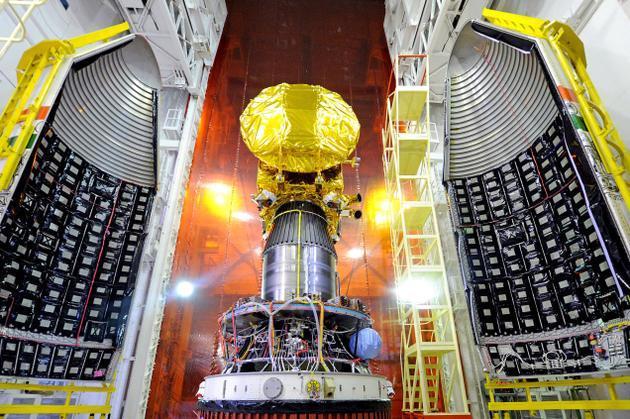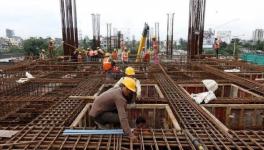India’s Mission to Mars
India’s Mars Mission started off in spectacular fashion on 5th November with a text book launch and precise positioning of the Mangalyaan (literally craft to Mars) spacecraft in its planned orbit around Earth. The successful launch was hailed in India as a tribute to the country’s growing technological prowess and an embellishment of national pride. Internationally, it was greeted mainly with considerable acclaim. But there was also some criticism, at home as well as abroad.
Unfortunately, most of the effusive praise as well as the criticism were clichéd. The former, especially in India, was prematurely self-congratulatory and too full of smug satisfaction to stomach even a hint of doubt: anyone raising critical issues was regarded as a party pooper, and any ifs and buts were attacked as rude interruptions of what should have been unadulterated celebration. The critiques, both in India and in western media, was almost all about Indian poverty and backwardness, and questioned, censured or even mocked India for embarking on a space mission, as if a developing country had no business getting engaged with advanced science and technology: this criticism left no room for any appreciation for a difficult job undertaken and done well, or for India adding to the pool of knowledge and capability. There were also many exaggerated comments about an Asian space race, about India trying to go one up on China in particular, a sentiment unfortunately echoed in India by some over-enthusiastic supporters of the mission.

Mangalyaan: the spacecraft (Courtesy: ISRO)
This article argues that understanding India’s Mars mission calls for putting aside these blinkers. The mission should be looked at in the context of India’s space programme, as part of a broader science and technology policy, itself located within the developmental path that India has embarked on since Independence.
In that context, it is indeed legitimate to raise questions about this Mars mission, its goals, deliverables and benefits. Any such mission or programme is about choices, what to do, when and how. What will be gained and at what cost? Surely nobody can argue that the Indian public or any concerned citizen cannot ask these or related queries.
Equally, can it be anybody’s case that all science, all quest for knowledge and capability, all creative endeavour, should only be weighed against one measure, namely its direct and immediate contribution to poverty alleviation? Do science, art or culture not have any autonomous place in the life of a nation and its people? Can all societal and developmental activity be reduced to either-or propositions? These are legitimate questions too.
But first let us take a closer look at the Mission itself.
Journey to Mars As originally announced by ISRO, the Mission to Mars was to be launched using the much more powerful GSLV (Geo-Stationary Launch Vehicle) rocket that would have carried a larger satellite with more instruments. Unfortunately, the GSLV could not be fully developed in time, and had encountered many failures, chiefly due to problems with the indigenous cryogenic stage. In the absence of the GSLV, the Mars Mission was reconfigured to a launch using ISRO’s tried and tested work horse, the PSLV (Polar Satellite Launch Vehicle). For this writer, it is very important to understand this change and its implications, because it has crucial bearing on the objectives and potential benefits or otherwise of the Mars Mission. The significance of this change has been missed by most commentators. It has been deliberately underplayed by proponents of the Mission and in order to boost public perceptions of achievements of India’s Mars Mission. A lack of understanding of this change among most critics has led to their either misplaced criticism or wholesale rejection of the entire Mars venture. Again for this writer, the use of PSLV has meant that India’s Mars Mission is sub-optimal and will not yield the originally expected benefits in scientific understanding nor advance Indian technological capability to the extent envisaged. But more of this later.
In the absence of the more powerful GSLV, the methodology adopted for the Mars Mission was similar to Chandrayaan-1, India’s earlier maiden mission to the Moon. Since PSLV does not have the power to directly take heavier spacecraft completely out of Earth’s gravitational pull into inter-planetary space, the strategy adopted was to put the craft into Earth orbit and then fling it into space in a sling-shot manoeuvre along a particular trajectory and use the solar system’s gravitational forces, along with small well-timed boosts, to get the spacecraft to the desired orbit around Mars, and earlier in Chandrayaan around the Moon.
The difference of course is that Chandrayaan had to travel only about 400,000km to the Moon whereas Mangalyaan or the Moon Orbiter Mission (MOM) would have traveled over 680 million km by the time it starts orbiting Mars.
Once there, the small scientific payload comprising 5 sets of instruments weighing just 13kg aboard the 1350kg spacecraft would begin their experiments. These different instruments would look for methane in the Martian atmosphere, measure hydrogen isotopes in the atmosphere so as to assess how water vapour may have escaped from Mars, look at the composition of the Martian surface through infra-red imagery and also photograph the red planet and its two Moons, Phobos and Deimos.
The methane experiments have come in for considerable criticism on the grounds that NASA’s Curiosity rover traveling on the Martian surface has not found any traces of methane, the charge being that India’s experiments are like re-inventing the wheel and nothing will come of it. This is uncharitable and mistaken to boot. Atmospheric measurements at various locations will yield different findings not necessarily available from near-surface readings from a limited area on Mars. ISRO has also been having discussions with NASA to explore areas of complementarity and configure the experiments accordingly.
It must be kept in mind that not all science is about spectacular “Eureka moments,” science is also about taking incremental steps and adding bits and pieces of knowledge complementary to pre-existing information and adding to a growing pool. Having said that, there is no escaping the fact that the science component of the Mission is quite low key, and limited in scope. Most of the limitations come from the small size of the spacecraft, the fuel it carries and the payload. These have also meant that the Orbiter will be in a highly elliptical orbit around Mars, going as far as 80,000km away from the surface, severely limiting the measurements and observations its instruments can make. And these limitations are, in turn, due to the low capacity of the PSLV launcher compared to the hitherto unavailable GSLV.
Complex maneuvres On November 5, the MOM spacecraft was placed precisely in its designated orbit around Earth in a highly elliptical orbit with perigee (shortest distance from the planet) of 246.9km and apogee (longest distance from the planet) of 23,566km. This elongated trajectory will be further elongated in stages and used to build up velocity of the craft till it is fast enough at the perigee to be flung out into space, escape Earth’s gravity and proceed towards Mars. It is proposed to do this through 6 successive burns or firing of booster rockets on the craft.
The first of these orbit-raising maneuvres or burns was successfully carried out early this morning (Thursday November 7) when MOM was placed in an orbit with apogee of around 28,793km. Subsequent burns will take the craft to 40,000km, 70,656 km, around 100,000km and lastly around 200,000km. After this, on December 1, the spacecraft will be flung out to inter-planetary space in a transfer orbit, first to orbit the sun and finally, on September 24, 2014, to where it can be captured by the gravity of Mars and start orbiting the red planet.
All these complex maneuvers, critically dependent on precision as regards both location and timing across millions of kilometers with the MOM spacecraft traveling at high speeds, will be controlled by ISRO’s Bangalore-based tracking centre ISTRAC which has now taken over mission control from the Sriharikota launch centre assisted by Indian ship-borne tracking systems positioned in the South Pacific near Fiji, and further aided by ground stations in Port Blair and Brunei and Biak in Indonesia, as well as NASA’s Deep Space Network’s stations in Canberra, Madrid and Goldstone in the US.
The Mangalyaan launch and the first orbit raising maneuver have gone extremely well so far. But there is a long way to go to September 24, 2014. As such, the current exultation and the proclamations of triumph at India’s maiden Martian venture where others such as China and Japan have failed, is premature. China’s Mars craft was unable to leave Earth orbit due to failure of the Russian launcher, whereas Japan’s spacecraft overshot Mars and could not capture the Martian gravity. Other attempts have crashed onto the Martian surface. India has the usual advantages of the late starter, learning from others’ mistakes and incorporating corrective or precautionary measures.
Limited achievement With all these limitations, if Mangalyaan does indeed succeed in entering stable Martian orbit and staying there conducting its scientific experiments even for a substantial part of the planned six months, ISRO and India would indeed have done well. But most of the kudos would be chiefly for just having reached Mars and placing a craft in orbit around it.
The original goal of the Mars Mission, announced when it was expected to be powered by GSLV, was to “develop the technologies required for design, planning, management and operations of an interplanetary mission.” Over the past week, ISRO spokespersons have been repeatedly emphasizing that the Mission is mainly a “technology demonstrator.” However, in the considered opinion of this writer, this Mission has been more of a “capability demonstrator,” to show India can do something like this.
If the Mars Mission had been undertaken with the GSLV, it would not only have yielded better science through deployment of more and better instruments, it would also importantly have showcased India’s heavy launch capability which India presently lacks. Without GSLV, India today depends on other nations such as the European Space Agency to launch high-orbit communications satellites for TV and telephony at more than 3 times the cost it would itself had incurred. And India continues to miss out on significant commercial opportunities that GSLV could provide.
For whatever reasons that can only be conjectured, despite knowing that GSLV would not be available for a 2013 Mars Mission, ISRO and India’s political leadership decided not to wait for the next window of opportunity in 2016 or 2018, and put more human and financial resources into development and proving of the GSLV, but to go ahead with a PSLV-based mission even though the scientific and technological dividends would be modest. Perhaps the calculus was that the prestige dividend and the morale boost for ISRO, quite discomfited by repeated failures of the GSLV, and for the people at large, would compensate. These objectives are not ignoble and maybe one should not turn one’s nose up at them. But one should acknowledge all this and put all factors into perspective while evaluating India’s Mars Mission.
The poverty debate Finally, the big debate about whether India, as a poor developing country, with such a high percentage of its people suffering from poverty, malnourishment, food insecurity, poor sanitation and so on, should spend so much money on a space mission, that too to Mars, with little or no tangible benefits for the Indian poor or the Indian people in general.
The Mars Mission will cost around Rs.450 crore or $75 million, less than a sixth of NASA’s MAVEN Mission to Mars later this month. As space missions go, this is low cost indeed. It is also a very small proportion of India’s space programme budget, which is itself only 0.35% of India’s total budget. And within this comparatively small space budget, which goes mostly into satellites for communication, weather and remote sensing, navigation, and launch vehicle development such as for GSLV, the budget for science and exploration is only 8%. Should one grudge a notably small fraction going to science and developing technological capability?
Would it make a big difference to India’s poverty alleviation effort, for which lakhs of crores are supposedly earmarked, if these Rs.400 crores are not spent on the space programme? Surely, if poverty levels have not gone down, reasons lie in political economy, in resource allocation to benefit the rich and growing middle-classes, in poor implementation of anti-poverty programmes. Why look for scapegoats and easy targets like space ventures or science in general?
India’s space programme has been, almost uniquely in the world, and arguably even more so than the erstwhile Soviet Union’s, heavily oriented to applications, such as for education, remote sensing for mapping and locating natural resources, communications, weather observation and prediction (as during the recent Phailin cyclone in Odisha and AP) etc, in other words for direct developmental benefits rather than to scientific inquiry or exploration. In fact, critics of India’s science and technology policy point to low investment in basic sciences and scientific research as a major factor underlying India’s steady decline in global standings in both science and technological innovation.
To argue that even small expenditure on scientific research, currently at a miserable level of less than 1.5% of GDP, is wasteful unless it delivers immediate and tangible benefits on the ground is retrograde, completely mis-understands the relationship between science and technological advancement, and stands in opposition to India’s self-reliant path of development. India’s future development calls not for abandoning science and scientific research but in orienting it better or differently both for short-term benefits as well as for longer-term developmental dividends.
Disclaimer: The views expressed here are the author's personal views, and do not necessarily represent the views of Newsclick
Get the latest reports & analysis with people's perspective on Protests, movements & deep analytical videos, discussions of the current affairs in your Telegram app. Subscribe to NewsClick's Telegram channel & get Real-Time updates on stories, as they get published on our website.























